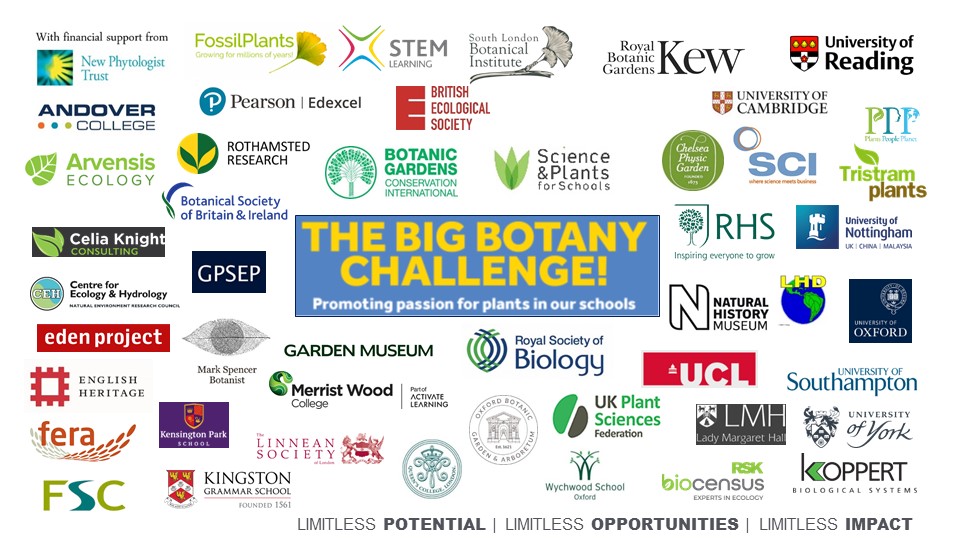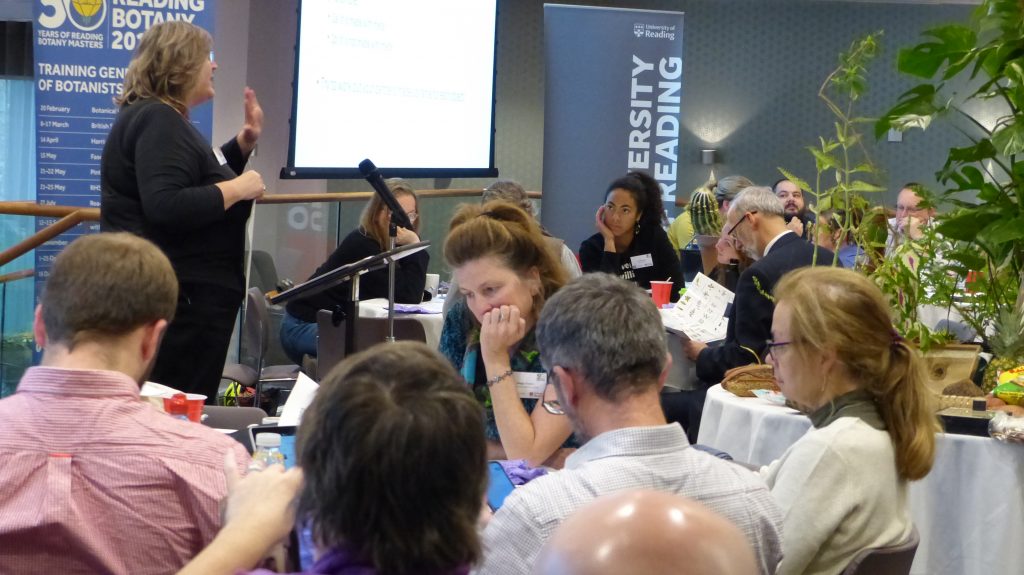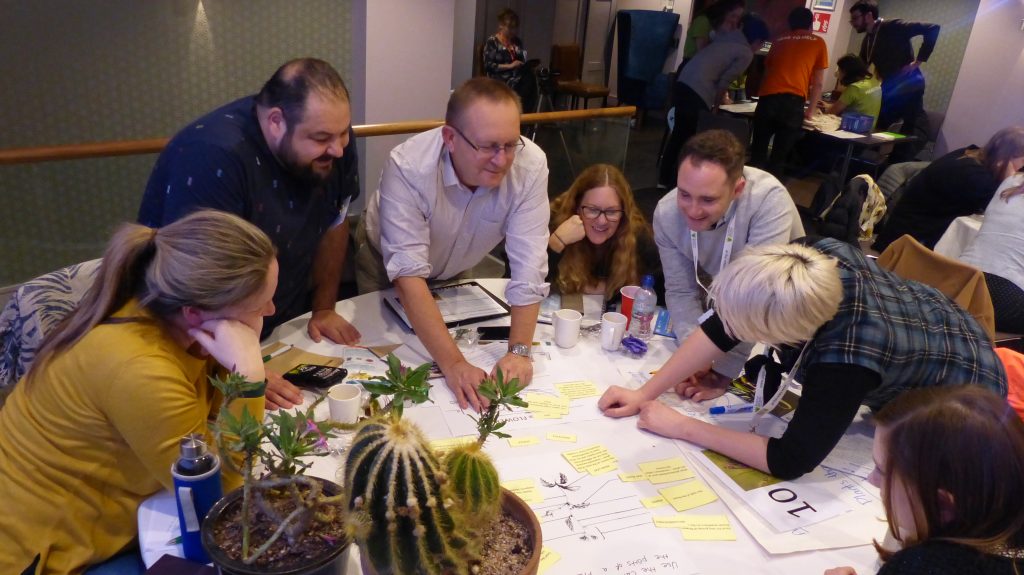Why do we need to promote passion for plants in secondary schools?
Plants are everywhere. They define our sense of place. Plants are beautiful, extraordinary, diverse and fundamentally essential for our well-being and survival. Our planet would not function as we know it without them. Every plant connects us to our own natural history as a species through folklore and culture. But despite all this, people tend to see plants only as the background to life on Earth, undervaluing their fascination and importance. This is what we call plant blindness.
Are we reinforcing plant blindness by how we teach plants in schools? Is the natural curiosity of primary school children eroded as soon as they hit secondary education?

Perhaps we must ask ourselves in this age when young people are demonstrating unprecedented concerns about climate change, species extinction and health and dietary choices, how should we be teaching the next generation about plants to inspire in them greater well-being, awareness and understanding?

What if we unleash the mind-blowing world of plant diversity on school children before they learn about photosynthesis and xylem and phloem in a nondescript plant? What if we train up and support teachers to have more confidence with plants?
Reading Botany Symposium November 2019
To begin to address these issues, the symposium ‘The Big Botany Challenge!’, brainchild of botanical trainer and plant ecologist Jonathan Mitchley supported by the Symposium Committee, was held at University of Reading on Friday 8th November 2019, representing one of the most diverse and wide-ranging plant education meetings ever held in Britain.
Over eighty delegates and presenters came from at least fifty different organisations comprising schools, education specialists, exam boards, botanic gardens, research institutions, industry specialists and conservation bodies to debate the urgent issue of enhancing the profile of plants in the national curriculum in secondary schools, promoting greater breadth in resources, improving botanical training and support for teachers, suggesting plants for the classroom and developing clearer career pathways to make the diverse range of plant-related employment more visible to teachers and school students. This symposium provided new impetus and direction to the overriding consensus that the UK requires a clearer strategy to integrate a wider-ranging scope encompassing all parts of the educational pipeline if we are to be able to adequately address the issues of our time.

Keynotes
A highlight of the symposium was the keynote presentation by Stephen Blackmore (Chair of the Board at Botanic Gardens Conservation International) on ‘The plight of British botany: international perspectives’ in which he demonstrated how botany has been kicked by accident out of the educational pipeline in Britain as establishments have been taken over by market forces. This is in stark contrast to some other countries and he cited China as an example, which has produced its own integrated approach through China’s Strategy for Plant Conservation, and which actively promotes plant science education and research as a collaboration of disciplines. It acknowledges that improving scientific capability and science capital within society lies at the heart of addressing the enormous challenges we face today such as sustainability and species and ecosystem conservation. Julie Hawkins (University of Reading) put forward the challenges of women in science within the concept of a leaky pipeline and highlighted the all-too-common story of lack of encouragement (and in some cases, positive discouragement) within schools for those wishing to embark on a botanical career pathway.
Great plant stories to use in the classroom
The first session presented some examples of how plants provide fascinating stories that can be used in the classroom to captivate interest, not just in biology lessons but also other subjects such as in geography, history, chemistry and english for example. Frank Mayle (University of Reading) brought in a range of common items including one of his very own wellie boots, giving a clear illustration that plants from the Amazon with a multitude of everyday uses that we can all identify with, can be used as windows into understanding the Amazon and its people. Robbie Blackhall-Miles (of Fossil Plants) demonstrated how he uses wonderful plants including some ‘weird fern relatives’ in recent work with some school children who are passionate to understand more about how to tackle the carbon challenge. Nigel Chaffey (#Plants R Us) used cotton as just one of many examples of ‘teaching botany by stealth…’ by using plant stories, particularly of those plants that have shaped our world, in a wide range of subject contexts other than biology. Finally, Chris Thorogood (from Oxford Botanic Gardens) showed how introducing extraordinary plant structures such as pitcher plants (“killer plants”) can open up a world of wonder in the classroom.

Opening up career pathways
The next session provided examples through talks and posters on how we can increase awareness of the diverse range of plant-related career pathways available. Celia Knight spoke about her immense body of work to improving educational pathways to the plant health profession for which she has recently received an MBE. Her work has demonstrated the impact of better joined up thinking by introducing students to the subject through the Gatsby Plant Science Summer School as they embark on their undergraduate degrees. Tamjid Mujtaba showed research into science capital and raising awareness, motivation and aspirations for science careers. Chaired by Simon Mortimer (University of Reading), a key outcome of this session and discussions amongst delegates was the importance to find and promote better links with school career advisory services to help students at the time they are making their higher education choices. Examples given were using STEM ambassadors and creating better links with industry and research specialists within schools and career portals.
Making the best of plants in the secondary curriculum
This key session included Hannah Cheek from Pearson Edexcel who considered whether assessment contributes to the lack of emphasis on plants in the curriculum. She explained the constraints from the Department of Education on what exam boards must include and showed how they maximise opportunities to include plant-related content. Ann Scott from the University of York who directed the development of the Salters-Nuffield Advanced Biology project, discussed how context-led A level teaching can raise the profile of plant biology. SAPs (Science and Plants for Schools) is a major provider of resources for teachers of plant biology, and Dan Jenkins (Head of the Gatsby Plant Science Education Programme) gave an insight into his work and interactions with teachers using the material. Marcus Grace from the University of Southampton put forward ideas on what role plant science should play in citizenship science. Guided by STEM consultant Angela Hall, a mind-mapping exercise was used to evaluate current plant-related content in the secondary school curriculum which enabled delegates to discuss ways to use this to help build students’ science capital and aspirations.

What makes a great plant resource to inspire teachers & school students?
Three plant teaching resources and a range of “cool plants for hot classrooms” were presented at the delegates tables and used to discuss what makes a great plant resource for the classroom. These included ‘transport in plants’ from SAPS and using and making keys with newly-qualified biology teacher John-Paul Flavell (Kingston Grammar School). Sue Townsend, Biodiversity Learning Manager at the Field Studies Council (FSC), showed how familiarity leads to understanding using a botanical terms exercise and FSC fold-out guides that FSC Publications had generously provided to each delegate at the symposium. Unfortunately Zephaniah Lindo from the RHS Campaign for School Gardening was unable to attend; he was going to showcase training and resources for secondary teachers. There was a consensus within the room that gardening within schools is an important element in this debate on many levels.
Cool Plants for Hot Classrooms – a #mygreenstudy project
Each symposium table was given some houseplants from the central display in the room provided by Alastair Culham (University of Reading) which he then used to show how easily you can grow teaching resources within the classroom. He showcased these plants, suited to grow in hot dry environments like classrooms, as a great way to introduce students to the beauty and fun of plants as well as being useful for teaching topics within the curriculum. And far better than wilting carrots on a windowsill!
Practical outputs and next steps for making secondary education a better place for discovering the joy of plants
Chaired by Sue Townsend and Jonathan Mitchley, delegates working in their table groups were asked to discuss eight questions related the the symposium themes to elicit short-term and longer-term actions to enhance the profile of plants in the school curriculum that were then shared with the room. These generated discussions and an approach to identify how different organisations and individuals might take actions forward beyond the symposium.
Next Steps
A follow-up meeting similar to this symposium is being discussed as a possible next step by one of the organisations present. The Big Botany Challenge! symposium committee will meet early in the new year to consider the outcomes of this event and to invite further individuals and organisations (including those who could not make it to the November symposium) into the collaborative discussions to help move the process to the next stage.
Judging by the energy and enthusiasm in the room, the Big Botany Challenge! symposium demonstrated that learning about plants is fun!

Symposium information:
- Check out the Symposium Booklet here: Big Botany Challenge booklet web
- An audit of the plant content of the National Curriculum is here: National Curriculum for plants audit_AH_2019
STOP PRESS: Horticultural Skill Survey 2019
Just published is a survey of more than 1,100 businesses commissioned by the Ornamental Horticulture Roundtable Group which has shown that environmental factors are the main driver for change in the future of the ornamental plant sector. A shortage of skills and access to labour followed environmental issues as the other top drivers for change. Organisations surveyed include: AHDB Horticulture, Royal Horticultural Society, Arboricultural Association, British Association of Landscape Industries, Chartered institute of Horticulture and Landex co-funded the activity. In association with the Horticultural Trades Association and National Farmers’ Union. Research specialist Pye Tait Consulting gathered data and carried out interviews between April and June 2019.
The complete reports can be downloaded here
Relevant publications
Listed below are some selected relevant publications on the symposium themes. Please feel free to send us further references and pdfs of any relevant material to add to this portfolio.
Bebbington, A. (2005). The ability of A-level students to name plants. Journal of Biological Education, 39(2), 63-67. PDF
Buck, T., Bruchmann, I., Zumstein, P., & Drees, C. (2019). Just a small bunch of flowers: the botanical knowledge of students and the positive effects of courses in plant identification at German universities. PeerJ, 7, e6581. PDF
Drea, S. (2011). The End of the Botany Degree in the UK. Bioscience Education, 17(1), 1-7. PDF
Flannery, M. C. (2019). Interview with Maura C. Flannery: Drawing trees to see and appreciate them. Plants, People, Planet, 1(3), 150-152. PDF
Friedersdorff, J. C., Thomas, B. J., Hay, H. R., Freeth‐Thomas, B. A., & Creevey, C. J. (2019). From treetops to tabletops: a preliminary investigation of how plants are represented in popular modern board games. Plants, People, Planet, 1(3), 290-300. PDF
Hartman, T., Lydon, S. J., & Rasmussen, A. (2019). Hunting for answers: Linking lectures with the real world using a mobile treasure hunt app. Plants, People, Planet. PDF
Hiscock, S. J., Wilkin, P., Lennon, S., & Young, B. (2019). Plants matter: Introducing Plants, People, Planet. Plants, People, Planet, 1(1), 2-4. PDF
Jose, S. B., Wu, C. H., & Kamoun, S. (2019). Overcoming plant blindness in science, education, and society. Plants, People, Planet, 1(3), 169-172. PDF
Knapp, S. (2019). Are humans really blind to plants? Plants, People, Planet. 1(3), PDF
Kramer, A. T., Zorn-Arnold, B., & Havens, K. (2013). Applying Lessons from the US Botanical Capacity Assessment Project to Achieve 2020 Global Strategy for Plant Conservation Targets1. Annals of the Missouri Botanical Garden, 99 (2), 172-180. PDF
Krishnan, S., Moreau, T., Kuehny, J., Novy, A., Greene, S. L., & Khoury, C. K. (2019). Resetting the table for people and plants: Botanic gardens and research organizations collaborate to address food and agricultural plant blindness. Plants, People, Planet. PDF
Lampert, P., Scheuch, M., Pany, P., Müllner, B., & Kiehn, M. (2019). Understanding students’ conceptions of plant reproduction to better teach plant biology in schools. Plants, People, Planet, 1(3), 248-260. PDF
Law, L. (2019). Interview with Lucinda Law: Finding inspiration in plants – The life and work of a botanical artist. Plants, People, Planet, 1(3), 146-149. PDF
Levesley, A., Jopson, J., & Knight, C. (2012). The Gatsby Plant Science Summer School: inspiring the next generation of plant science researchers. The Plant Cell, 24(4), 1306-1315. PDF
editorial (2019). Loving the alien. Nature Plants 5, 551. PDF
McDonough MacKenzie, C., Kuebbing, S., Barak, R. S., Bletz, M., Dudney, J., McGill, B. M., …& Tonietto, R. K. (2019). We do not want to “cure plant blindness” we want to grow plant love. Plants, People, Planet, 1(3), 139-141. PDF
McLeod, L. (2018). Developing a framework for the biology curriculum. School Science Review, 370: 23-29. The Association for Science Education. PDF
Pany, P., Lörnitzo, A., Auleitner, L., Heidinger, C., Lampert, P., & Kiehn, M. (2019). Using students’ interest in useful plants to encourage plant vision in the classroom. Plants, People, Planet, 1(3), 261-270. PDF
Royal Society of Biology Strategic Plan 2019-2021. Biology Changing the World. PDF
Stagg, P., Stanley, J., & Leisten, R. (2004). Life Study: Biology A level in the 21st century. Report. London, UK: Wellcome Trust. PDF
Stagg, P., Wahlberg, W., Laczik, A., & Huddleston, P. (2009). The uptake of plant sciences in the UK. A research project for the Gatsby Charitable Foundation. Coventry, UK: University of Warwick, The Centre for Education and Industry. PDF
Thomas, H. (2019). Grass blindness. Plants, People, Planet. PDF
Wyner, Y., & Doherty, J. H. (2019). Seeing the trees: what urban middle school students notice about the street trees that surround them. Journal of Biological Education, 1-23. PDF
